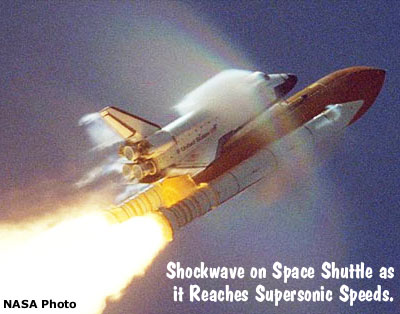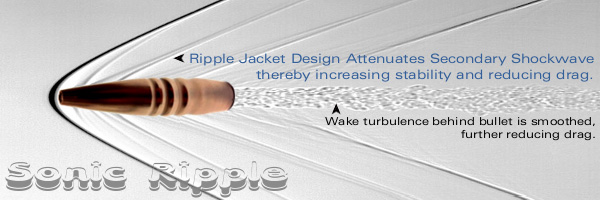September 22nd, 2014
One of our Forum Members has a .308 Win load that dips into the transonic speed range at 1000 yards. He is concerned that his bullets may lose accuracy as they slow to transonic speeds: “My target is at 1000 yards. How important to accuracy is it to keep the bullet supersonic (Mach 1.2) all the way to the target? How does slowing to transonic speeds in the last 100 yards or so affect accuracy?”
TargetShooter Magazine and AccurateShooter.com contributor Laurie Holland offers some practical answers to this important question, based on his his experience with .223 and .308-caliber bullets.
Thoughts on Accuracy and Transonic Bullet Speeds by Laurie Davidson.
There is no simple answer to the question “How do transonic speeds affect accuracy”. Some bullets manage OK, some not so well, some fail entirely, and I’ve never seen a guide as to which models do and which don’t. But we do have the ‘boat-tail angle rule’, anyway. Bryan Litz says the ideal boat-tail angle is 7-9°. Go much above 10° and it’s too steep for the air to follow the bullet sides around to the base. This seems to manifest itself as much increased drag and turbulence leading to instability in transonic flight.
It is this effect that has led to the common advice of “Don’t use 168gr 30-caliber bullets at 1000 yards”. That is misleading advice as it resulted from use of the 168gr Sierra ‘International’ (aka MatchKing) bullet with its 13-deg BT angle. (This was, originally, a specialized 300m design — there are various near copies on the market from Speer, Hornady and Nosler.) By contrast, Berger 168-grainers are designed as long-range bullets with 8.9, 8.5 and a really nice 7° angle on the BT, VLD and Hybrid respectively. Hornady A-Max 30-cal projectiles (other than the 208-grainer) fall into this enforced shorter-range bracket too thanks to their 12.6° (and greater) boat-tail angles. (155gr = 13.5°, 168gr = 12.87°, and 178gr = 12.6°.)

Even this boat-tail angle ‘rule’ doesn’t always seem to apply. Many older long-range Service Rifle shooters talk about good results at 1000 yards with some batches of 7.62mm match ammo in their 20″-barreled M14s using the 168gn SMK. I’ve successfully used Hornady and Sierra 168s at 1000 yards in 30-cal magnums which drive the bullets fast enough to keep out of trouble at this distance. This is still not recommended of course thanks to their low BCs compared to better long-range speciality bullets.

These four photos show the substantial changes in the shock ware and turbulence patterns for the same bullet at different velocities. The “M” stands for Mach and the numerical value represents the velocity of the bullet relative to the speed of sound at the time of the shot. Photos by Beat Kneubuehl.
Transonic Issues with .223 Rem in F-TR
I was much exercised by [concerns about transonic instability] in the early days of F-Class, when I was shooting a .223 Rem with 80-grainers at 2,800 fps MV or even a bit less. Even the optimistic G1 ballistic charts of the time said they’d be subsonic at 1000 yards. (Bryan Litz’s Point Mass Ballistic Solver 2.0’s program says 1,078 fps at 1000 yards at 2,800 fps MV in standard conditions for the SMK; below 1.2 MACH beyond a point somewhere around 780 yards.) In fact they shot fine in a large range of conditions apart from needing around 60% more windage allowance than 6.5mm projectiles [shot with a larger cartridge]. The biggest problem apart from my wind-reading skills was constantly getting out of the rhythm to call to have the target pulled as the pits crew didn’t hear the subsonic bullets and had trouble seeing their little holes.
In the early days of F-TR I used a 24″ barrel factory tactical rifle that was billed as F-TR ready — it wasn’t! The much touted 175gr Sierra MatchKing, as used in the US military M118LR sniper round, was allegedly good at 1000 yards at .308 velocities — but it wasn’t! It would group OK in [some calm] conditions, but any significant change would cause a much greater deflection on the target than the ballistic charts predicted, so transonic flight was obviously making it barely stable. I also suspect conditions on the day had a big effect as Litz’s program says [the 175gr SMK] is just subsonic at 2,650 fps MV at 1,000 in standard conditions. Throw in MV spread and there was a risk of some round remaining supersonic, while others went transonic. Plus warmer or colder air moving onto the range under some conditions might change things.
I used the combination on Scotland’s notorious Blair Atholl range at 1000 yards in one competition in a day of cold headwinds from the north and frequent rain squalls. The temperatures plummeted during the squalls (and the wind went mad too!) and what was an ‘interesting group pattern’ outside of squall conditions changed to seeing me do well to just stay on the target frame at all. On ranges other than Blair (which is electronic, so no pits crew), target markers reported they heard faint supersonic ‘crack’ and saw round holes on the paper, so the bullets appeared to remain stable and just supersonic in summer shooting conditions.
Transonic Problems with M118LR 7.62×51 Ammo
Confirmation of this transonic performance phenomenon has since come from USMC snipers who say the M118LR’s performance ‘falls off a cliff’ beyond 800m (875 yards), which is just what I found when shooting the bullet at slightly higher than M118LR muzzle velocities. A move to the 190gr SMK with Vihtavuori N550 keeping the MVs reasonable gave a vast improvement in 1000-yard performance.
Practical Advice — Use a Bullet That Stays Supersonic
The ‘easy’ / better answer to all this is to use a design such as the 30-caliber, 185gr Berger LRBT with a reputation for good long range performance and to load it to achieve or exceed 1,350 fps at 1000 yards. If I can get the combination I’m using to be predicted to hold 1,400 fps at this range in a G7-based program calculation, I’m happier still.
Incidentally, the old long-range, 30-cal Sierra bullets (the venerable 190gr, 200gr, and 220gr MatchKings), with their extra length boat-tail sections, have a superb reputation for stable transonic / subsonic flight. They were used by GB and British Commonwealth ‘Match Rifle’ shooters at 1000, 1100, and 1200 yards for many years before the current bunch of 210gr and up VLDs and Hybrids appeared.
 Transonic vs. Supersonic Transonic vs. Supersonic
The term “Transonic” refers to velocities in the range of Mach 0.8 to 1.0, i.e. 600–768 mph. It is formally defined as the range of speeds between the critical Mach number, when some parts of the airflow are supersonic, and a higher speed, typically near Mach 1.2, when the vast majority of the airflow is supersonic. Instability can occur at transonic speeds. Shock waves move through the air at the speed of sound. When an aircraft goes transonic and approaches the speed of sound, these shock waves build up in front of it to form a single, very large shock wave. This is dramatically illustrated in this Space Shuttle photo. |
Share the post "Practical Thoughts About Transonic Bullet Stability and Accuracy"
















 Transonic vs. Supersonic
Transonic vs. Supersonic


 The Science of the Sonic Ripple Bullet Design
The Science of the Sonic Ripple Bullet Design





